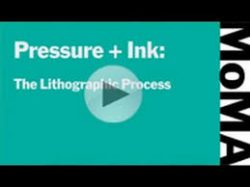ABOUT STONE LITHOGRAPHY
I had long admired the stone lithographs of a number of artists, most notably Grant Wood and M.C Escher, when I finally had the opportunity to learn this printmaking technique at the Lyme Academy College of Fine Arts. I then later continued working in lithography with Master Printer, James Reed. What drew me in was the expressive possibilities inherent in this method that yields a rich full range of tonal values and the ability to reproduce with impressive fidelity all the character and nuances of the original drawing.

Stone lithography, developed around 1798 in Germany, is based on the hydrophobic (water repelling) property of grease. To create a lithograph the image is drawn on a smooth, level limestone plate using oil-based lithographic drawing materials that, as solids, come in the form of crayons, pencils, or rubbing sticks and, as liquids, come in the form of tusche and autographic ink. The image at right shows the finished drawing on the stone for my lithograph Hydrangeas. Once the drawing is complete a series of chemical processes are used to bond the hydrophobic (oil attracting and water repelling), grease based, image to the stone and make it ready to be inked for printing. During printing, the stone is kept continuously wet with water as the image is inked, a process that requires numerous passes with an inking roller. After the image is loaded with printing ink, the stone and paper are run through a press that applies uniform pressure to transfer the ink onto the paper. An excellent video by the Museum of Modern Art "Pressure + Ink: Lithography Process" illustrates this process.
During the creation of an edition of stone lithographs a certain amount of experimentation takes place. Different papers and inks are tested and, inevitably some impressions are considered not suitable to include as part of the edition. These prints can be regarded as stand-alone works separate from the edition or they may serve as a foundation for applying color using a variety of media or for developing a different image. The images below are an example of a stone lithograph and an oil painting later done over the same image.

Handmade lithographs are often confused with more commercial and widely prevalent offset lithographs. Printing done by offset lithography uses a photograph of the original that is separated into colors, typically four (red, yellow, blue, and black), and transferred onto separate plates for each. The printing for offset lithography is then done all at once, mechanically, on large high speed presses. In contrast, handmade lithographs are created by the artist drawing directly on the plate (stone and metal can be used). After the image is chemically secured, the printer inks the stone or metal plate by hand and pulls it through the press for each individual impression in the edition. Prints produced using the mechanized offset lithography process result in an image that is more of an approximation of the original, with a loss in the nuances of the drawing and color, and with a telltale uniform dot pattern that is often visible to the naked eye or under low magnification. On the other hand, stone lithographs retain the detail of the artist's drawing, include the beauty of the fine random pattern of the grain of the stone, and may vary slightly from one impression to the next in the edition. It is for these reasons that, soon after it was developed in Germany, stone lithography quickly spread among artists working in Europe, including Francisco de Goya and most major French artists at some point in their careers (Daumier, Cezanne, Manet, Degas, Picasso, Redon, among others), and is a technique that continues to attract the interest of artists today.
--- Catherine Christiano
WHAT'S THE DIFFERENCE BETWEEN A FINE ART PRINT AND A REPRODUCTION?
Although these two words seem synonymous the difference between them is important, especially to collectors. A print is an original work of art, whereas a reproduction is a printed copy of an original work of art. Original fine art prints are created with the direct involvement of the artist. If the master image is created by the artist using a stone or plate, the printing may be done either by the artist or by someone under the artist's supervision. The master image may also be created digitally, where the artist begins with digital photography or scans, manipulates the image using software like Photoshop, and electronically prints the image. On the other hand, reproductions are created by taking a very high resolution photograph or scan of an original work of art and printing the image electronically. The best quality prints and reproductions are approved and signed by the artist. In general, a print will be of higher value that a similarly sized reproduction by the same artist.

